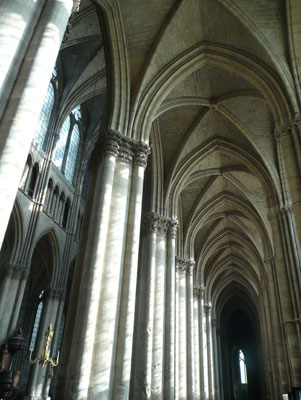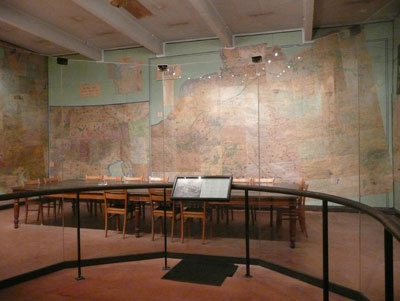Musée de la Reddition in Reims
Reims, a large city (188,000 inhabitants) in northeast France, is often described as the heart of the Champagne country.
For my wife, Arlene, and me, the main attraction during our Sept. 22-26, 2008, visit there was the majestic Notre-Dame de Reims, where for over 200 years the kings of France were crowned, the most famous being Charles VII (with Joan d’Arc at his side).
Construction of the cathedral was started in 1211 and took 100 years, although it was never completed according to the original plans. Badly damaged in World War I, it was carefully restored with funds donated by John D. Rockefeller. Damaged again in World War II, it was again carefully restored, although restoration and refurbishment is a continuous process even to the present day.
The cathedral is particularly noted for its awesome Gothic style and for a magnificent, 13th-century, great rose stained-glass window of the Virgin Mary in her Assumption. There are also a number of smaller windows by Marc Chagall that were installed in 1974.
It is difficult to describe the splendor of this cathedral, as it is overwhelming. For me, it made real the words, “You feel like you are in a cathedral,” something normally said to describe the indescribable.
Adjacent to the cathedral is the residence of the archbishop of Reims, the Palace of Tau‚ modified in 1690 to the Baroque style seen today. This also was the place where the princes of France about to be crowned resided. The coronation banquets were held there; the first documented one was in 990 and the last, that of Charles X, in 1825. Now it is a museum and contains numerous priceless artifacts from before 990 up to the present day.
Verdun and the surrounding battlegrounds of 1916 are only a few miles away. During the Battle of Verdun in 1916 the French lost more than 160,000 men. In addition, 210,000 were wounded and 101,000 went missing. German deaths totaled 143,000, with the total of killed and wounded on both sides about 714,000.
There is one very historical museum that receives very few visitors: Musée de la Reddition, or the Museum of Surrender (12 rue Franklin Roosevelt; phone 03 26 47 84 19), where at 2:41 a.m. on May 7th, 1945, by order of Admiral Karl Dönitz, General Alfred Jodl, chief of operations staff of the German armed forces, signed the unconditional surrender of all the Third Reich’s armed forces, ending the war in Europe.
At that time, the red-brick building, which had been a technical college, was General Eisenhower’s supreme headquarters. The building is still in use today as a lyceum, the Lycée Roosevelt Reims. The war room where the articles of surrender were signed is at one end of the building and is on the second floor. The street entrance has five flags flying on the sidewalk, those of France, the UK, the USA, Russia and Germany, so it is not easy to miss.
There are displays of original artifacts from that period, and the war room where the surrender took place still has the original battle maps on the walls. The original table where the surrender was signed is in this room, and each chair has the name of the person who sat in it engraved on the back.
The whole experience of visiting it gave me the goosebumps. I was born and grew up in England during World War II, and my town was subjected to continuous air raids and numerous bombings. It was a very melancholic sensation to realize it all had ended in this pathetic school classroom.
The museum, located about a 25-minute walk west of the cathedral, is open 10 a.m.-noon and 2-6 p.m. Wednesday-Monday. Admission costs €5. Reims is easy to explore on foot or by a city tour bus, which in an hour takes in all the highlights.
BERNARD GOODHEAD
La Jolla, CA


